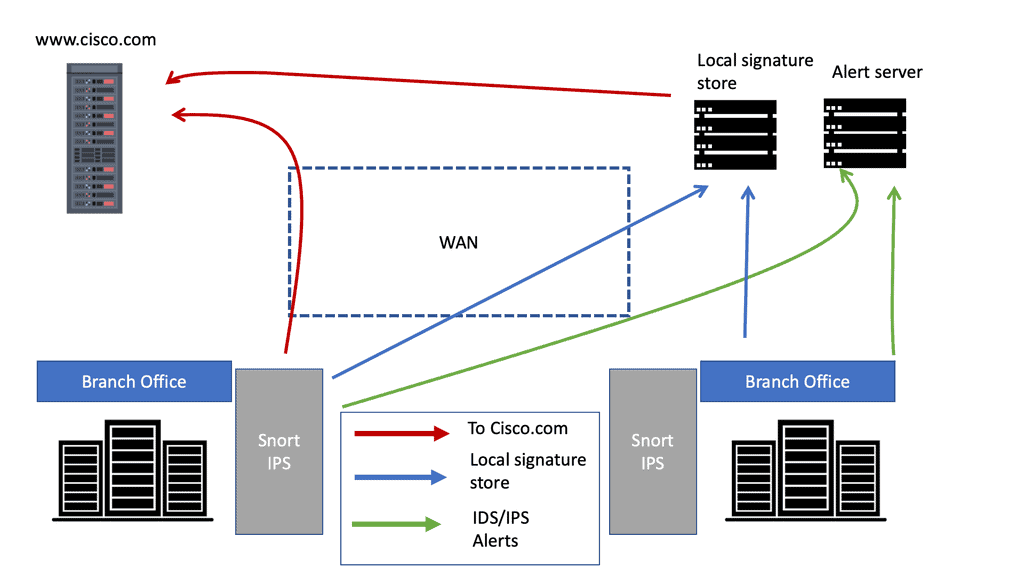First and foremost, let’s begin with what a firewall is.
A firewall is a network security device that monitors and controls incoming and outgoing network traffic to protect computer networks from attacks. It serves as a barrier between the internal network and the outside world, letting safe traffic through while restricting hazardous data. Firewalls are critical for both enterprises and individuals to protect themselves against hackers and malware attacks. They might take the form of hardware, software, or cloud-based services and are an important aspect of network security.
Now that we have cleared that up, let us go over what IDS and IPS actually mean.
Both IDS (Intrusion Detection System) and IPS (Intrusion Prevention System) are cybersecurity systems that monitor network traffic and activity in order to detect and respond to possible attacks.
The definitions of firewall and IDS/IPS have one thing in common: they both detect and stop network attacks. There are, however, distinctions between these technologies.
The fundamental distinctions between firewalls and IDS/IPS will be discussed briefly in this article. The following are the topics we shall discuss:
- Functionality
- Focus
- Detection Methods
- Response Capability
- Placement
Functionality
Let’s take a quick look at the functional differences between these technologies.
Firewalls primarily focus on traffic filtering based on predefined rules, while IDS/IPS systems analyze traffic behavior and take action accordingly. Firewalls cannot prevent attacks but provide a first line of defense by filtering traffic. IDS can detect attacks in real-time and alert the administrator, while IPS goes beyond detection and actively takes measures to prevent attacks. Firewalls are typically placed at the network perimeter, while IDS/IPS can be placed on the internal network. Firewalls have a minimal impact on network performance, while IDS/IPS systems can have a significant impact depending on their complexity.
| Functionality | Firewall | IDS/IPS |
| Traffic Filtering | Filters traffic based on predefined rules | Analyzes traffic behavior and takes action accordingly |
| Attack Prevention | Cannot prevent attacks | Can detect and prevent attacks in real-time |
| Response Capability | Does not take direct action to prevent or stop attacks | Can take action to block or mitigate attacks |
| Placement | Placed at the network perimeter | Placed on the internal network |
| Performance Impact | Minimal impact on network performance | Can significantly impact network performance, depending on the complexity |
Focus
The major difference between a firewall and an IDS/IPS comes down to how they handle network security. A firewall’s primary function is to filter traffic based on established rules, permitting or banning certain connections depending on protocols, ports, or IP addresses. Its primary function is to operate as a network gatekeeper, managing traffic flow and preventing unauthorized access.
IDS/IPS systems, on the other hand, are focused on real-time monitoring and detection of network abnormalities. They examine network traffic patterns and behavior in order to detect possible dangers such as intrusion attempts or malicious activity. IDS/IPS, as opposed to firewalls, is more proactive in nature since it may identify new attack patterns and create alerts to notify administrators of possible security concerns.
Detection Methods
The primary difference between a firewall and an IDS or IPS in terms of detection techniques is the approaches they utilize to identify and respond to possible security threats.
Firewalls generally utilize stateful inspection, packet filtering, and proxy services to manage traffic based on specified rules. They concentrate on network traffic filtering and access control, allowing or denying certain connections based on protocols, ports, or IP addresses. Firewalls serve as a barrier between the internal network and the outside world, but they are not designed to actively identify and respond to security threats in real time.
IDS/IPS systems, on the other hand, use more sophisticated detection methods. They employ signature-based detection to identify known patterns of malicious activity, anomaly detection to detect deviations from normal network behavior, and behavior analysis to identify suspicious actions. IDS/IPS systems are capable of monitoring and analyzing network traffic in real time, allowing them to detect possible security issues as they arise.
Response Capability
Firewalls essentially prevent unwanted access and provide network protection by blocking or permitting traffic based on specified criteria. They are largely reactive in nature, responding to traffic based on predefined regulations but doing little more than blocking or permitting traffic.
IDS/IPS systems, on the other hand, have a more proactive reaction capacity. When possible security threats or anomalies are found, they can produce alerts and notify administrators in real time. Moreover, IDS and IPS can make proactive efforts to prevent prospective attacks from inflicting harm. This might involve dynamically changing security rules, banning particular IP addresses, or adopting other preventative actions.
| Aspect | Firewall | IDS/IPS |
| Response Capability | Prevents unauthorized access | Alerts administrators on potential threats |
| Action | Blocks or allows traffic based on rules | Generates alerts for potential threats |
| Proactive Measures | Largely reactive, based on predefined rules | Proactive, can take action to prevent potential threats |
| Real-time Action | No | Yes |
| Active Measures | No | Yes |
| Prevention | Yes | Yes |
Placement
Firewalls are often placed on the network’s perimeter, between the internal and external networks. Its primary function is to control and manage traffic between these two networks by permitting or disallowing certain connections based on predetermined criteria. Firewalls serve as a barrier, monitoring traffic before it enters or exits the internal network, and so operate as the first line of protection against external threats.
IDS/IPS systems, on the other hand, are located within the internal network. They are intended to monitor and analyze traffic within the internal network, with an emphasis on identifying anomalies, potential security concerns, or suspicious actions that may occur. IDS/IPS systems monitor and analyze internal network traffic in real-time to detect and respond to security events or attacks.
| Aspect | Firewall | IDS/IPS |
| Placement | Typically, at the network perimeter | Positioned within the internal network |
| Purpose | Control traffic between internal and external networks | Monitor traffic within the internal network |
| Network Scope | External network boundary | Internal network monitoring |
| Real-time Monitoring | No | Yes |
| Traffic Monitoring | Incoming and outgoing traffic | Internal network traffic |



































